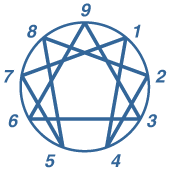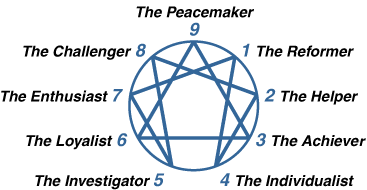|
The Enneagram
This explanation covers the basics that you will need to understand how the Enneagram works, and will be especially helpful for beginners. As you will see, only a few simple concepts are needed to begin your journey of self-discovery. The Enneagram, however, is ultimately subtle and complex, as you will appreciate the more you use it in your life. For more guidelines and information visit www.enneagraminstitute.com
Structure
The Enneagram's structure may look complicated, although it is actually simple. It will help you understand the Enneagram if you sketch it yourself.
Draw a circle and mark nine equidistant points on its circumference. Designate each point by a number from one to nine, with nine at the top, for symmetry and by convention. Each point represents one of the nine basic personality types.
The nine points on the circumference are also connected with each other by the inner lines of the Enneagram. Note that points Three, Six, and Nine form an equilateral triangle. The remaining six points are connected in the following order: One connects with Four, Four with Two, Two with Eight, Eight with Five, Five with Seven, and Seven with One. These six points form an irregular hexagram. The meaning of these inner lines will be discussed shortly.

Your Basic Personality Type
From one point of view, the Enneagram can be seen as a set of nine distinct personality types, with each number on the Enneagram denoting one type. It is common to find a little of yourself in all nine of the types, although one of them should stand out as being closest to yourself. This is your basic personality type.
Everyone emerges from childhood with one of the nine types dominating their personality, with inborn temperament and other pre-natal factors being the main determinants of our type. This is one area where most all of the major Enneagram authors agree — we are born with a dominant type. Subsequently, this inborn orientation largely determines the ways in which we learn to adapt to our early childhood environment. It also seems to lead to certain unconscious orientations toward our parental figures, but why this is so, we still do not know. In any case, by the time children are four or five years old, their consciousness has developed sufficiently to have a separate sense of self. Although their identity is still very fluid, at this age children begin to establish themselves and find ways of fitting into the world on their own.
Thus, the overall orientation of our personality reflects the totality of all childhood factors (including genetics) that influenced its development.
Several more points can be made about the basic type itself.
-
People do not change from one basic personality type to another.
-
The descriptions of the personality types are universal and apply equally to males and females, since no type is inherently masculine or feminine.
-
Not everything in the description of your basic type will apply to you all the time because you fluctuate constantly among the healthy, average, and unhealthy traits that make up your personality type.
-
The Enneagram uses numbers to designate each of the types because numbers are value neutral — they imply the whole range of attitudes and behaviors of each type without specifying anything either positive or negative. Unlike the labels used in psychiatry, numbers provide an unbiased, shorthand way of indicating a lot about a person without being pejorative.
-
The numerical ranking of the types is not significant. A larger number is no better than a smaller number; it is not better to be a Nine than a Two because nine is a bigger number.
-
No type is inherently better or worse than any other. While all the personality types have unique assets and liabilities, some types are often more desirable than others in any given culture or group. Furthermore, for one reason or another, you may not be happy being a particular type. You may feel that your type is "handicapped" in some way. As you learn more about all the types, you will see that just as each has unique capacities, each has different limitations. If some types are more esteemed in Western society than others, it is because of the qualities that society rewards, not because of any superior value of those types. The ideal is to become your best self, not to imitate the assets of another type.
Identifying Your Basic Personality Type
As you think about your personality, which of the following nine roles fits you best most of the time? Or, to put it differently, if you were to describe yourself in a few words, which of the following word clusters would come closest?

These one-word descriptors can be expanded into four-word sets of traits. Keep in mind that these are merely highlights and do not represent the full spectrum of each type.
Type One is principled, purposeful, self-controlled, and perfectionistic.
Type Two is generous, demonstrative, people-pleasing, and possessive.
Type Three is adaptable, excelling, driven, and image-conscious.
Type Four is expressive, dramatic, self-absorbed, and temperamental.
Type Five is perceptive, innovative, secretive, and provocative.
Type Six is engaging, responsible, anxious, and suspicious.
Type Seven is spontaneous, versatile, distractible, and scattered.
Type Eight is self-confident, decisive, willful, and confrontational.
Type Nine is receptive, reassuring, agreeable, and complacent.
|